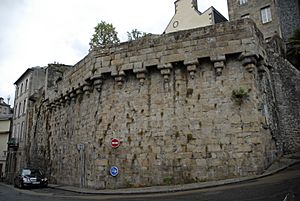Siege of Morlaix (1594) facts for kids
The siege of Morlaix happened from September 6 to September 17, 1594. It was a battle during the French Wars of Religion and the Anglo-Spanish War (1585–1604). The fight was between the French Royal army, helped by English soldiers, and the combined forces of Spain and the Catholic League of France. The French and English forces surrounded the town of Morlaix. Spanish troops and Catholic League soldiers tried to help the town, but English forces stopped them. When English ships arrived with powerful cannons, the defenders of Morlaix quickly gave up.
Quick facts for kids Siege of Morlaix |
|||||||
|---|---|---|---|---|---|---|---|
| Part of the French Wars of Religion | |||||||
 Ramparts of the old wall of Morlaix |
|||||||
|
|||||||
| Belligerents | |||||||
| Commanders and leaders | |||||||
| Strength | |||||||
|
5,000
|
unknown | ||||||
| Casualties and losses | |||||||
| Low | Garrison surrendered | ||||||
Contents
Why Did the Siege of Morlaix Happen?
Since 1562, France had been in a long period of fighting called the French Wars of Religion. In these wars, different groups fought over their religious beliefs. Spain often got involved to support the Catholic League in France. King Henry IV of France was fighting for the Protestant side. However, in 1593, he decided to become a Catholic. This change helped him gain more support. Many towns and leaders of the Catholic League then joined King Henry's side.
King Henry then focused on taking back important towns. These towns were near the Spanish Netherlands, which was controlled by Spain. He also remembered his promise to Elizabeth I of England, who had been helping him.
How Did the Armies Prepare?
Marshal Jean d'Aumont was a French military leader. He was sent to Brittany, a region in France. His job was to join the English army led by Sir John Norreys. This English army was already fighting in Brittany. Many towns in the area decided to support King Henry when d'Aumont arrived with his large army.
The castle in the town of Morlaix was very important. It was like a key to controlling the area. The Catholic League and Spanish troops held this castle. Taking it back was a big goal for King Henry's forces.
The Siege of Morlaix Begins
A combined force of Catholic League soldiers and Spanish troops decided to try and help Morlaix. These forces were led by the Duke of Mercoeur and Juan d'Aguila. Marshal D'Aumont had already joined the English army under Norreys. Queen Elizabeth I of England had asked that Morlaix be given to the English as a safe place. However, D'Aumont tried to avoid this by saying only Catholics could enter the town.
Stopping the Relief Forces
D'Aumont soon realized that a big battle was likely. The Duke of Mercœur sent his League forces towards Morlaix. They marched very quickly, hoping to meet up with the Spanish force led by Juan Del Aguila. But Norreys and his English troops moved along the coast. They blocked the path of Mercœur's forces, stopping them from joining the Spanish.
Norreys's approach made Mercœur nervous. Mercœur quickly pulled his troops back to a strong position near Morlaix. Norreys then sent 700 English soldiers to show their strength. This made Mercœur abandon his good position. Aguila's Spanish troops were close to meeting Mercœur's force. However, they ran into a small group of English soldiers. Aguila thought he was facing a much larger army. The Spanish believed there were 6,000 English soldiers, but it was only a small part of Norreys's army.
Fearing they would be surrounded, Aguila decided to retreat his men. He pulled back to Blavet on September 17. This meant Mercœur could not get help to the castle of Morlaix. After this failure, Aguila and Mercœur started blaming each other.
Morlaix Surrenders
Things got even worse for the defenders inside Morlaix. They saw an English fleet of ships arriving. These ships were led by Sir Martin Frobisher. They carried heavy cannons for Norreys's army to use in the siege. When the defenders saw the English ships with their cannons ready, they lost hope. They also heard that no help was coming from Mercœur or Aguila. Because of this, the garrison quickly surrendered.
What Happened After the Siege?
The soldiers defending Morlaix marched out of the town. The English and French forces then entered in victory. The English army under Norreys had successfully stopped two larger enemy forces. They put both the Catholic League and Spanish armies on the defensive, forcing them to retreat. Marshal D'Aumont praised Norreys highly. He even allowed Norreys to enter the town first, which pleased Queen Elizabeth.
After Morlaix was captured, many more towns decided to join King Henry's side. Soon after, Norreys also captured Quimper and Guingamp. But the biggest prize was Brest. Specifically, there was a Spanish fort on a headland that controlled the Gironde area. This fort was taken in a very tough attack. The entire Spanish group defending the fort was lost. However, nearly a quarter of the attacking forces were also lost, including Martin Frobisher. Taking this fort meant Spain could not have a major military base there.
English troops left France in February of the next year. Queen Elizabeth was then able to send her soldiers back to the Netherlands for other battles.

